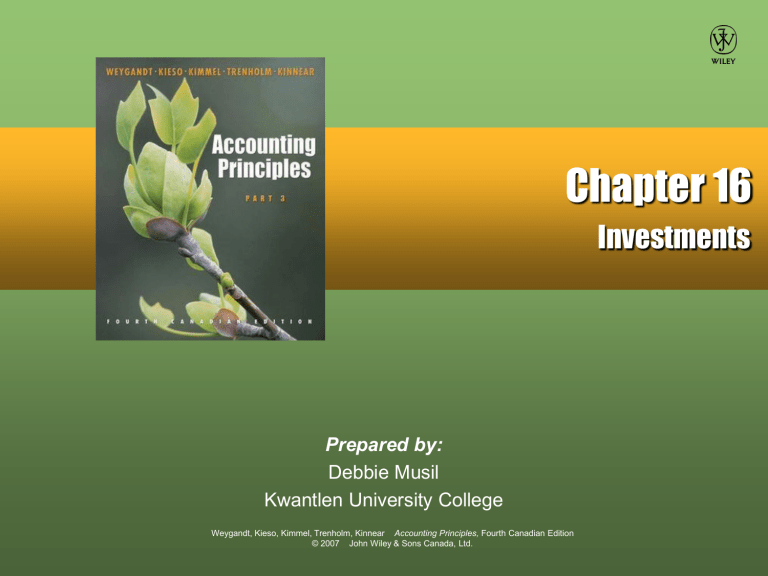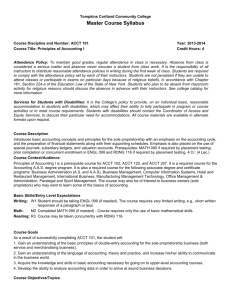Accounting Principles, 4th Cdn. Edition

Prepared by:
Debbie Musil
Kwantlen University College
Weygandt, Kieso, Kimmel, Trenholm, Kinnear Accounting Principles, Fourth Canadian Edition
© 2007 John Wiley & Sons Canada, Ltd.
Chapter 16
Investments
Investments
•
•
•
•
•
Classification of investments
• Short-term versus long-term
Accounting for debt investments
• Short-term and long-term debt investments
Accounting for equity investments
• Cost and equity methods
Valuation of passive investments
• Trading, available-for-sale, held-to-maturity
Reporting of investments
Weygandt, Kieso, Kimmel, Trenholm, Kinnear Accounting Principles, Fourth Canadian Edition
© 2007 John Wiley & Sons Canada, Ltd.
Classification of Investments
•
•
Corporations can invest in:
• Debt securities: money-market, bonds, commercial paper
• Equity securities: preferred and common shares
Reasons to invest:
• Passive investments: use excess cash, generate investment income
• Strategic investments: to influence or control another company
Weygandt, Kieso, Kimmel, Trenholm, Kinnear Accounting Principles, Fourth Canadian Edition
© 2007 John Wiley & Sons Canada, Ltd.
Short-Term Investments
•
•
Debt or equity securities that either :
• Are readily marketable: can be easily sold whenever cash is needed, or
• Mature within the next year
Can be classified as either:
• Trading securities: purchased and held for resale in the short term, hopefully at a gain
• Available-for-sale securities: not trading securities or held-to-maturity securities
• Intention to sell them at some time in the future
• Can be short or long-term based on criteria met
Weygandt, Kieso, Kimmel, Trenholm, Kinnear Accounting Principles, Fourth Canadian Edition
© 2007 John Wiley & Sons Canada, Ltd.
Long-Term Investments
•
•
Investments that are both:
• Not readily marketable, and
• Do not mature within one year
Classified as either:
• Available-for-sale securities: not trading securities or held-to-maturity securities
• Intention to sell them at some time in the future
• Can be short or long-term based on criteria met
• Held-to-maturity securities: intention to hold debt security until it matures
Weygandt, Kieso, Kimmel, Trenholm, Kinnear Accounting Principles, Fourth Canadian Edition
© 2007 John Wiley & Sons Canada, Ltd.
Accounting for Short-Term Debt
Investments
•
• If actively managed and traded: trading securities
Otherwise: available-for-sale securities
•
•
Money-market instruments
Usually pay a fixed interest rate on maturity
Purchase:
Nov. 30 Available-for-Sale - Term Deposit
Cash
To record purchase of 3-month, 2% term deposit
5,000
5,000
Weygandt, Kieso, Kimmel, Trenholm, Kinnear Accounting Principles, Fourth Canadian Edition
© 2007 John Wiley & Sons Canada, Ltd.
Accounting for Short-Term Debt
Investments 2
•
Money-market instruments
Accruing interest revenue:
Dec. 31 Interest Receivable
Interest Revenue
To accrue interest on term deposit ($5,000 x 2% x 1/12)
8
8
• Maturity:
Feb.28
Cash
Interest Receivable
Interest Revenue ($5,000 x 2% x 2/12)
Available-for-Sale - Term Deposit
To record maturity of term deposit
Weygandt, Kieso, Kimmel, Trenholm, Kinnear Accounting Principles, Fourth Canadian Edition
© 2007 John Wiley & Sons Canada, Ltd.
5,025
8
17
5,000
Accounting for Short-Term Debt
Investments 3
•
•
Bonds
Recording of investments in bonds differs in three ways:
• Cost: may include a discount or premium
• Timing of interest: usually received semi-annually
• Sale of bond: may be before maturity, with gain or loss
Purchase:
Jan. 1 Available-for-Sale - Doan Bonds
Cash
To record purchase of Doan bonds
49,000
49,000
Weygandt, Kieso, Kimmel, Trenholm, Kinnear Accounting Principles, Fourth Canadian Edition
© 2007 John Wiley & Sons Canada, Ltd.
Accounting for Short-Term Debt
Investments 4
•
Bonds
Recording interest revenue:
July 1 Cash
Interest Revenue
To record receipt of interest on Doan bonds
1,500
1,500
• Sale of bonds before maturity:
Feb.28
Cash
Available-for-Sale - Doan Bonds
Gain on Sale of Available-for-Sale Securities
To record sale of Doan bonds
Weygandt, Kieso, Kimmel, Trenholm, Kinnear Accounting Principles, Fourth Canadian Edition
© 2007 John Wiley & Sons Canada, Ltd.
50,500
49,000
1,500
•
Accounting for Long-Term Debt
Investments
Purchase:
• Recording is similar to short-term investments
• Any discount or premium on purchase is not recorded separately
Jan. 1 Held-to-Maturity - ABC Bonds
Cash
To record purchase of ABC bonds
101,000
101,000
• Recording interest revenue:
• Any discount or premium is amortized to interest revenue over the remaining term of the bonds
July 1 Cash
Held-to-Maturity - ABC Bonds
Interest Revenue
To record receipt of interest on ABC Bonds
3,500
290
3,210
Weygandt, Kieso, Kimmel, Trenholm, Kinnear Accounting Principles, Fourth Canadian Edition
© 2007 John Wiley & Sons Canada, Ltd.
Accounting for Equity Investments
• Based on how much influence investor has over the issuing corporation:
• Short-term investments: investment is accounted for using the cost method
• Long-term investments:
• < 20% ownership – little influence – use cost method to account for investment
• ≥ 20% ownership – significant influence – use equity method to account for investment
Weygandt, Kieso, Kimmel, Trenholm, Kinnear Accounting Principles, Fourth Canadian Edition
© 2007 John Wiley & Sons Canada, Ltd.
Accounting for Equity Investments:
Cost Method
• Investment is recorded at purchase price (cost)
July 1 Available-for-Sale - Beal Common Shares
Cash (1,000 shares x $40)
To record purchase of 1,000 common shares
40,000
40,000
• Revenue recognized when cash dividends are received
Dec. 1 Cash (1,000 x $2)
Dividend Revenue
To record cash dividend of $2 per share
2,000
2,000
• When shares are sold, difference between proceeds of sale and cost or carrying value of shares is recognized as a gain or loss
Weygandt, Kieso, Kimmel, Trenholm, Kinnear Accounting Principles, Fourth Canadian Edition
© 2007 John Wiley & Sons Canada, Ltd.
Accounting for Equity Investments:
Equity Method
•
• Investment is recorded at cost (same as cost method)
Investor’s share of investee’s net income is recognized as an increase in the value of the investment
Dec. 31 Equity Investment - Beck Common Shares
Revenue from Equity Investment in Beck
To record 30% equity in Beck's net income of $100,000
30,000
30,000
• Dividends received are recognized as a decrease in the value of the investment
Dec. 31 Cash
Equity Investment - Beck Common Shares
To record dividends received (30% of $40,000)
12,000
12,000
Weygandt, Kieso, Kimmel, Trenholm, Kinnear Accounting Principles, Fourth Canadian Edition
© 2007 John Wiley & Sons Canada, Ltd.
Valuation of Passive Investments
• Depends upon classification of investment:
• Trading securities and available-for-sale securities:
• Valued at market value
• Changes in market value are reported as an unrealized gain or loss
• Held-to-maturity securities:
• Valued at amortized cost (premiums and discounts are amortized)
• Value is not adjusted for changes in market value unless permanent impairment occurs
Weygandt, Kieso, Kimmel, Trenholm, Kinnear Accounting Principles, Fourth Canadian Edition
© 2007 John Wiley & Sons Canada, Ltd.
Valuation at Market Value:
Unrealized Gains & Losses
• Changes in market value of trading and available-forsale securities are treated as unrealized gains or losses
Dec. 31 Allowance to Adjust Trading Securities to Market Value
Unrealized Gain - Trading Securities
To record unrealized gain on trading securities
3,000
3,000
•
•
Allowance account is used to record difference between cost and market and is reported on the balance sheet
Unrealized gain is reported:
• For trading securities: in the income statement
• For available-for-sale securities: as other comprehensive income
Weygandt, Kieso, Kimmel, Trenholm, Kinnear Accounting Principles, Fourth Canadian Edition
© 2007 John Wiley & Sons Canada, Ltd.
Reporting of Investments:
Balance Sheet
Short-Term Investments
• Highly liquid investments with a maturity < three months are included in “Cash and Cash
Equivalents”
• Trading securities and available-for-sale securities (if short-term) are listed next
• Valuation adjustment to market may be listed separately on the balance sheet or in the notes
Long-Term Investments
• Available-for-sale (if long-term) at market
Weygandt, Kieso, Kimmel, Trenholm, Kinnear Accounting Principles, Fourth Canadian Edition
© 2007 John Wiley & Sons Canada, Ltd.
Reporting of Investments:
Balance Sheet 2
Long-Term Investments (continued)
• Held-to-maturity at amortized cost
• Maturities within one year are classified as shortterm
• Equity investments where significant influence
Accumulated Other Comprehensive Income
• Presented in the shareholders’ equity section
• The cumulative total of all comprehensive income (loss) from available-for-sale securities and other sources
Weygandt, Kieso, Kimmel, Trenholm, Kinnear Accounting Principles, Fourth Canadian Edition
© 2007 John Wiley & Sons Canada, Ltd.
Reporting of Investments:
Income Statement
Income Statement
• Other revenue/expense includes:
• Realized gains/losses on investments
• Unrealized gains/losses on trading securities
• Other investment income: interest, dividends
Statement of Comprehensive Income
• Unrealized gains/losses on available-for-sale securities
Weygandt, Kieso, Kimmel, Trenholm, Kinnear Accounting Principles, Fourth Canadian Edition
© 2007 John Wiley & Sons Canada, Ltd.
Consolidated Financial Statements
•
•
When a company (parent) controls another company (subsidiary):
• Owns more than 50% of another company, or
• Other factors that indicate control
Consolidated financial statements are also required
• Present the total assets and liabilities controlled by the parent company
• In addition to financial statements of each separate company
Weygandt, Kieso, Kimmel, Trenholm, Kinnear Accounting Principles, Fourth Canadian Edition
© 2007 John Wiley & Sons Canada, Ltd.
COPYRIGHT
Copyright © 2007 John Wiley & Sons Canada, Ltd. All rights reserved. Reproduction or translation of this work beyond that permitted by Access Copyright (The Canadian Copyright
Licensing Agency) is unlawful. Requests for further information should be addressed to the Permissions Department, John Wiley
& Sons Canada, Ltd. The purchaser may make back-up copies for his or her own use only and not for distribution or resale. The author and the publisher assume no responsibility for errors, omissions, or damages caused by the use of these programs or from the use of the information contained herein.
Weygandt, Kieso, Kimmel, Trenholm, Kinnear Accounting Principles, Fourth Canadian Edition
© 2007 John Wiley & Sons Canada, Ltd.


